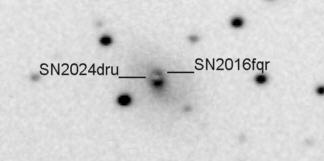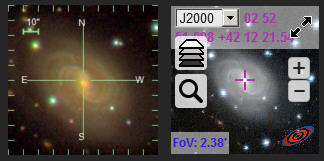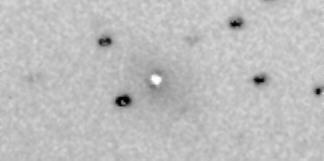

Left: Image of SN2016fqr subtracted from image of SN2024dru of 2024 March 08.800 UT. Unfortunately, the image from 2016 had a higher signal than the new one. Therefore, all the bright stars and galaxies appear dark. Also, SN2016fqr north of the galaxy center appears dark. However, a brighter spot at the position of SN2024dru is visible. This object is brighter than the galaxy in the 2016 image and is likely SN2024dru which I could not resolve otherwise in the new image, i.e. separate the supernova from the galaxy core, although I reduced the exposure time to 60 seconds per subframe to limit the blur due to turbulent air. For the image of Sn2016fqr I used subexposures of 180 seconds, hence the larger signal.
Image of 2024 March 08.800 UT. Image size: 400%. The positions of SN2024dru (bright) and SN2016fqr (dark) are marked. Refractor 140 mm @ f/5.4 - Camera Atik 460EX - Exposures: 90 x 60 s through luminance filter.
Image by M. Mrotzek
Right: Screenshot of position of SN2024dru from Transient Name Server (TNS). SN2024dru exploded 1.2" west and 3.4" north of the galaxy core which is quite challenging to separate both objects considering the turbulent air at my location inside a residential area.
SN2024dru was a type Ia supernova discovered 2024 March 02. Type Ia supernovae occur when a white dwarf explodes in a close binary star system converting its complete mass of approximately 1.4 solar masses into energy.
